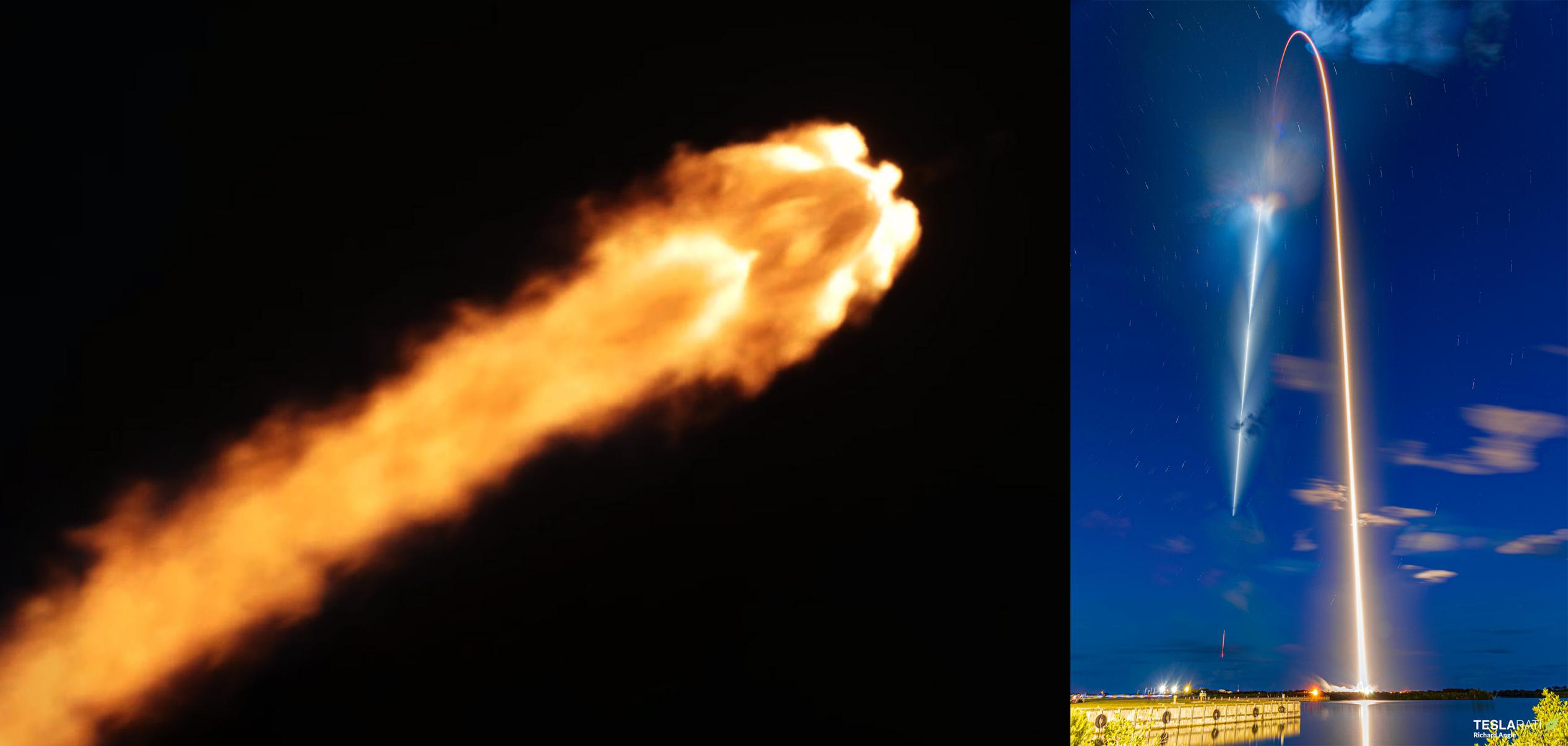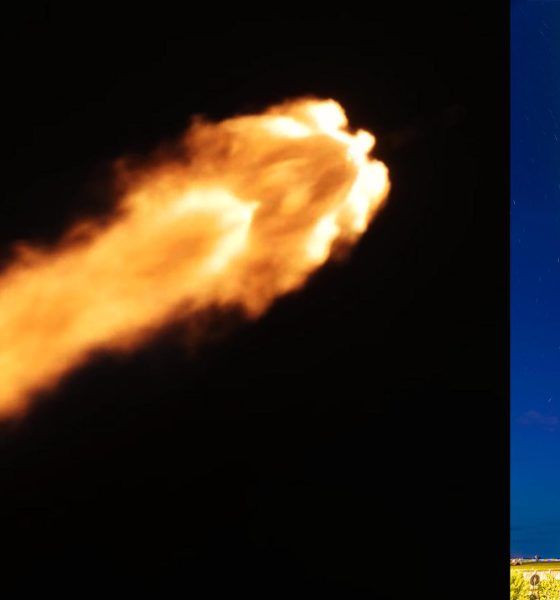

News
SpaceX rockets private astronaut crew into orbit for the first time in spaceflight history
For the first time in spaceflight history, a crew of all-private astronauts have rocketed into orbit – and on a SpaceX Falcon 9 rocket and Crew Dragon spacecraft.
Right on schedule, just before 8:03 pm EDT, an orbit-proven Crew Dragon spacecraft lifted off from Kennedy Space Center Pad 39A on a twice-flown Falcon 9 booster and new upper stage. Making it look easy, the booster performed flawlessly on its third spaceflight, boosting Dragon towards orbit and nailing a landing aboard drone ship Just Read The Instructions (JRTI). About 2.5 minutes after launch, Falcon 9’s upper stage took over and burned for another six minutes to precisely inject the spacecraft and its unprecedented all-private crew of Inspiration4 astronauts into an approximately 200 km (125 mi) parking orbit.
With that single feat, SpaceX has boosted the number of private citizens that have reached Earth orbit by 50% – from 8 to 12. Unlike any of the eight other private orbital spaceflights in history, though, Crew Dragon will now use its built-in Draco maneuvering thrusters to boost its orbital apogee (peak) to around 575 km (357 mi) – the highest altitude reached by private citizens in the history of spaceflight and by astronauts in general since 2009.
Assuming Dragon successfully reaches its planned apogee, Inspiration4 will mark the seventh-highest stable Earth orbit ever reached by humans and the first private (orbital) launch to fly astronauts in a flight-proven spacecraft. Heralding the array of firsts it marked, Inspiration4’s launch window also coincidentally opened just half an hour after sunset at Cape Canaveral, Florida, providing a famously spectacular view to onlookers as Falcon 9 and Dragon ascended back into sunlight for the majority of the launch.
Against the night sky present for those on the ground, the rocket’s miles-long and miles-wide exhaust plume was lit up by the long-since-set sun, producing an affectionately named ‘jellyfish’ that was visible for hundreds of miles.
Created by billionaire and mission commander Jared Isaacman, Inspiration4 could mark a turning point for genuine orbital space tourism, which has been limited to just eight private citizens in the history of spaceflight. While Dragon is far from affordable, with seats believed to cost tens of millions of dollars each, a combination of factors mean that it might be the first spacecraft in history to truly enable orbital space tourism at an unprecedented scale. Already, SpaceX has another four – and possibly five – Crew Dragon launches of four astronauts each scheduled to fly in just the next two years, more than doubling the number of private citizens that have reached orbit if all goes to plan.
Hinted at by its name, Inspiration4’s primary goal has been to inspire people around the world and to hopefully raise awareness that humanity is on the cusp of a future where spaceflight will be accessible to millions – not hundreds – of people. Inspiration4 member Haley Arceneaux is now the youngest American, first person with a prosthetic device, and first cancer survivor to reach orbit. Thanks to the mission, Dr. Sian Proctor has also become the first black woman in history to pilot a spacecraft to space or orbit.


Further, on top of $100M to be donated by Isaacman himself, Inspiration4 has managed to raise almost $35M in donations for St. Jude’s Children’s Hospital – one of the foremost cancer research and treatment hospitals in the US and the world.
Last but not least, the mission will also debut the largest spacecraft window ever flown in space or orbit – a modification to Crew Dragon called a cupola that SpaceX has now designed, built, qualified, and launched in less than a year.

News
Tesla aims to combat common Full Self-Driving problem with new patent
Tesla writes in the patent that its autonomous and semi-autonomous vehicles are heavily reliant on camera systems to navigate and interact with their environment.

Tesla is aiming to combat a common Full Self-Driving problem with a new patent.
One issue with Tesla’s vision-based approach is that sunlight glare can become a troublesome element of everyday travel. Full Self-Driving is certainly an amazing technology, but there are still things Tesla is aiming to figure out with its development.
Unfortunately, it is extremely difficult to get around this issue, and even humans need ways to combat it when they’re driving, as we commonly use sunglasses or sun visors to give us better visibility.
Cameras obviously do not have these ways to fight sunglare, but a new patent Tesla recently had published aims to fight this through a “glare shield.”
Tesla writes in the patent that its autonomous and semi-autonomous vehicles are heavily reliant on camera systems to navigate and interact with their environment.

The ability to see surroundings is crucial for accurate performance, and glare is one element of interference that has yet to be confronted.
Tesla described the patent, which will utilize “a textured surface composed of an array of micro-cones, or cone-shaped formations, which serve to scatter incident light in various directions, thereby reducing glare and improving camera vision.”

The patent was first spotted by Not a Tesla App.
The design of the micro-cones is the first element of the puzzle to fight the excess glare. The patent says they are “optimized in size, angle, and orientation to minimize Total Hemispherical Reflectance (THR) and reflection penalty, enhancing the camera’s ability to accurately interpret visual data.”
Additionally, there is an electromechanical system for dynamic orientation adjustment, which will allow the micro-cones to move based on the angle of external light sources.
This is not the only thing Tesla is mulling to resolve issues with sunlight glare, as it has also worked on two other ways to combat the problem. One thing the company has discussed is a direct photon count.
CEO Elon Musk said during the Q2 Earnings Call:
“We use an approach which is direct photon count. When you see a processed image, so the image that goes from the sort of photon counter — the silicon photon counter — that then goes through a digital signal processor or image signal processor, that’s normally what happens. And then the image that you see looks all washed out, because if you point the camera at the sun, the post-processing of the photon counting washes things out.”
Future Hardware iterations, like Hardware 5 and Hardware 6, could also integrate better solutions for the sunglare issue, such as neutral density filters or heated lenses, aiming to solve glare more effectively.
Elon Musk
Delaware Supreme Court reinstates Elon Musk’s 2018 Tesla CEO pay package
The unanimous decision criticized the prior total rescission as “improper and inequitable,” arguing that it left Musk uncompensated for six years of transformative leadership at Tesla.

The Delaware Supreme Court has overturned a lower court ruling, reinstating Elon Musk’s 2018 compensation package originally valued at $56 billion but now worth approximately $139 billion due to Tesla’s soaring stock price.
The unanimous decision criticized the prior total rescission as “improper and inequitable,” arguing that it left Musk uncompensated for six years of transformative leadership at Tesla. Musk quickly celebrated the outcome on X, stating that he felt “vindicated.” He also shared his gratitude to TSLA shareholders.
Delaware Supreme Court makes a decision
In a 49-page ruling Friday, the Delaware Supreme Court reversed Chancellor Kathaleen McCormick’s 2024 decision that voided the 2018 package over alleged board conflicts and inadequate shareholder disclosures. The high court acknowledged varying views on liability but agreed rescission was excessive, stating it “leaves Musk uncompensated for his time and efforts over a period of six years.”
The 2018 plan granted Musk options on about 304 million shares upon hitting aggressive milestones, all of which were achieved ahead of time. Shareholders overwhelmingly approved it initially in 2018 and ratified it once again in 2024 after the Delaware lower court struck it down. The case against Musk’s 2018 pay package was filed by plaintiff Richard Tornetta, who held just nine shares when the compensation plan was approved.
A hard-fought victory
As noted in a Reuters report, Tesla’s win avoids a potential $26 billion earnings hit from replacing the award at current prices. Tesla, now Texas-incorporated, had hedged with interim plans, including a November 2025 shareholder-approved package potentially worth $878 billion tied to Robotaxi and Optimus goals and other extremely aggressive operational milestones.
The saga surrounding Elon Musk’s 2018 pay package ultimately damaged Delaware’s corporate appeal, prompting a number of high-profile firms, such as Dropbox, Roblox, Trade Desk, and Coinbase, to follow Tesla’s exodus out of the state. What added more fuel to the issue was the fact that Tornetta’s legal team, following the lower court’s 2024 decision, demanded a fee request of more than $5.1 billion worth of TSLA stock, which was equal to an hourly rate of over $200,000.
Delaware Supreme Court Elon Musk 2018 Pay Package by Simon Alvarez
News
Tesla Cybercab tests are going on overdrive with production-ready units
Tesla is ramping its real-world tests of the Cybercab, with multiple sightings of the vehicle being reported across social media this week.

Tesla is ramping its real-world tests of the Cybercab, with multiple sightings of the autonomous two-seater being reported across social media this week. Based on videos of the vehicle that have been shared online, it appears that Cybercab tests are underway across multiple states.
Recent Cybercab sightings
Reports of Cybercab tests have ramped this week, with a vehicle that looked like a production-ready prototype being spotted at Apple’s Visitor Center in California. The vehicle in this sighting was interesting as it was equipped with a steering wheel. The vehicle also featured some changes to the design of its brake lights.
The Cybercab was also filmed testing at the Fremont factory’s test track, which also seemed to involve a vehicle that looked production-ready. This also seemed to be the case for a Cybercab that was spotted in Austin, Texas, which happened to be undergoing real-world tests. Overall, these sightings suggest that Cybercab testing is fully underway, and the vehicle is really moving towards production.
Production design all but finalized?
Recently, a near-production-ready Cybercab was showcased at Tesla’s Santana Row showroom in San Jose. The vehicle was equipped with frameless windows, dual windshield wipers, powered butterfly door struts, an extended front splitter, an updated lightbar, new wheel covers, and a license plate bracket. Interior updates include redesigned dash/door panels, refined seats with center cupholders, updated carpet, and what appeared to be improved legroom.
There seems to be a pretty good chance that the Cybercab’s design has been all but finalized, at least considering Elon Musk’s comments at the 2025 Annual Shareholder Meeting. During the event, Musk confirmed that the vehicle will enter production around April 2026, and its production targets will be quite ambitious.








